
At Your Boxes:
Nest building is proceeding nicely. Listen now for the rapid “tic-tic-tic” of the Ticking Calls that male Tree Swallows give when they want to copulate. You should see both successful and unsuccessful mating attempts in your Tree Swallows over the next couple of weeks. Watch closely to see if you can tell which sex, male or female, controls whether a copulation attempt is successful. Photo above by Ron Grant.
Also, when checking boxes look in the nest cup. If you can’t see through the feathers feel very gently in the cup. Reason: when copulations begin, egg laying will soon follow.
Concepts:
Mating is an extremely important event in a bird’s life. It’s the start of the path his or her genes take to pass into the next generation.
There appear to be two different situations for mating in Tree Swallows. The first is highly visible, and is the one you are almost certain to witness.
- This mode often starts when a male flies toward a female perched out in the open. He makes rapid Tic Calls as he approaches that signal he wants to copulate.
- The female perches with her back and tail held horizontal.
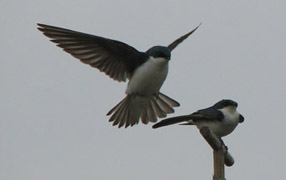
- The male lands on the female’s flattened back. He uses his wings for balance while he grabs her head feathers in his bill.
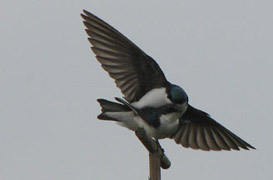
- The male pivots his tail under the female’s so his “cloaca” contacts hers, and his sperm is transferred to her.
- The actual cloaca to cloaca contact is quick. It only takes a few seconds to transfer the male’s sperm.
- A successful copulation usually involves multiple cloacal contacts, one after the other in rapid succession.
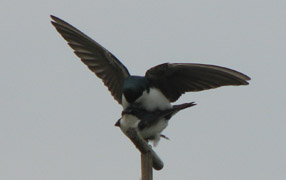
- Males often fly off briefly, then land again for more cloacal contacts.

- Here’s a YouTube video of Tree Swallows mating successfully. Notice how many cloacal contacts the pair in the video make.
If a female does not want to mate at this time, what can she do?
- She can easily prevent a male from copulating by not leveling her body. Or she can flip her tail up when he tries to land (see below).
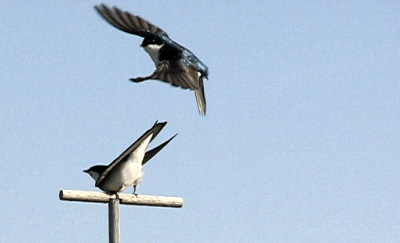
- She can also twist her head around and threaten him with her bill open.
- So a female Tree Swallow’s behavior can determine if a male’s copulation attempts while she is perching are successful or not. If she doesn’t want to, it won’t happen.
- Here’s a YouTube video that shows a female Tree Swallow rejecting a male’s attempts to copulate.
What is this “cloaca”?
- Birds have only one opening, the cloaca, for their digestive, excretory and reproductive systems.
- This cloaca (Latin for “sewer”) receives feces from the large intestine, uric acid from the kidneys, and either eggs or sperm from the gonads.
- These are all released to the outside through a single “vent” in the cloaca.
Does a male Tree Swallow have a penis?
- No, but male songbirds do develop a “cloacal protuberance” during the nesting season. The “CP” is a swelling of lower portions of the ducts that carry sperm from a male’s testes to his cloaca.
- The cloacal protuberance acts as a temporary holding chamber where a male’s sperm complete their development and are kept cool before their transfer to a female during mating.
- The CP below is typical of a male Tree Swallow in mating condition.
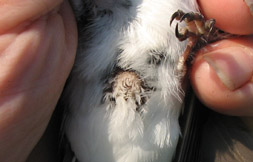
- The “CP” sticks out slightly and during mating in Tree Swallows it is everted farther. This helps the male transfer his sperm to the female’s cloaca.
- Note the male’s everted “CP” in Euan Reid’s photo below.
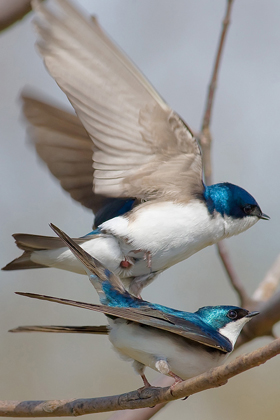
- And in case you were wondering, a female’s everted cloacal vent appears very similar, as you can see in the photo below by Juan G. Rodriguez.

- Once a male’s sperm have been transferred to a female swallow’s body she can keep them alive for several days in sperm storage tubules located in her reproductive tract until they are needed to fertilize an egg.
What is the second mode or situation in mating of Tree Swallows?
- Until the advent of in-box cameras we weren’t aware that Tree Swallow copulation is sometimes attempted out of our sight inside nest cavities.
- Recently we viewed videos taken by Francois Paquette of Quebec in which it appears within-box copulations may be forced on female swallows by males.
- What is your opinion after watching the Tube video of this behavior? Do you think it shows forced copulation or is the female receptive?
- Regardless of whether this copulation is forced or not, we presume it must succeed often enough for the behavior to be retained in this species.
The Forced Copulation video mentioned Extra-Pair Young. What does the term Extra-Pair Young mean? How does it affect mating behaviors in Tree Swallows?
- DNA studies of Tree Swallows show that resident females are almost always the biological mothers of all the young in their nests. In other words female Tree Swallows rarely sneak eggs into other females’ nests the way some bird species do.
- However, the same studies also revealed most Tree Swallow nests contain young fathered by more than one male through extra-pair copulations.
- In some nests non-resident males fathered most or even all the young! Some nests had young fathered by 3 or more different males!
- We assume this brood of six young in the hat below all have the same mother but may well have two or more different fathers.
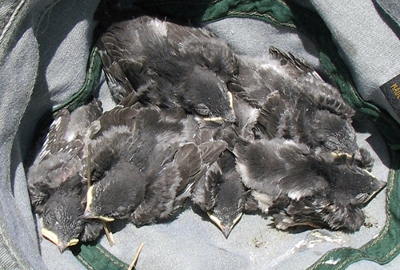
What’s going on here? Are females forced to copulate by other males or do they “cheat” on their resident partner?
- We’ve seen that in one situation female Tree Swallows can easily reject males trying to copulate. So in this situation at least “extra-pair” young aren’t the result of males forcing mating.
- These in-box copulations, whether forced or consensual, could produce some extra-pair young.
- But perhaps there are times when a female may encourage males other than her resident male to mate with her, or at least not reject their advances.
- Remember, both males and females “want” to pass on their genes to successful descendants, ones that are “good at being Tree Swallows.”
From the viewpoint of a female Tree Swallow “wanting” to pass on her genes:
- Maybe the only reason she paired with her resident male partner in the first place was because he possessed a nest cavity. So she accepts this male as her residence mate because she may not get another chance to produce offspring in her short life.
- Perhaps she is aware of other males whose physical appearance and behavior have shown her they have “better genes” than the male at her nest. If so, she can allow or seek copulations with these males in order to produce the most “fit” descendants she can.
- In fact research found that successful extra-pair males were usually older, experienced breeders, weighed more, had longer wings, had brighter plumage, and were in better condition generally than the resident male.
- Another possibility is that females seek to have young with more than one male because each male has a different combination of genes. In this way she could raise descendants with a wider variety of genetic makeup, increasing the chances that some might have what it takes to survive whatever unpredictable future environmental conditions they encounter.
But just like the females, resident males “want” to pass on their genes, to have their own line of successful descendants. So resident male Tree Swallows with boxes face a dilemma.
- For these males, raising young that aren’t their own is a defeat, a waste of time and energy.
- What can resident males can do to assure they will be the biological fathers of young in their own nests?
- Most male songbirds must choose between two strategies for “paternity assurance,” either Mate Guarding or Frequent Copulation.
A resident male Tree Swallow’s options are:
- Mate Guarding: He could follow his nest mate and guard her during the period when her eggs are ripening and they could be fertilized by another male’s sperm. He could prevent other males from approaching her, and prevent her from accepting or soliciting their copulations. But if he followed her constantly the nest cavity he fought so hard for might be taken over by another male.
- Frequent Copulation: Instead of following his nest mate during her fertile period, he could concentrate on guarding his nest cavity. But when she was present he could try to copulate with her as frequently as she allowed. Then, even if she did copulate with other males, his own sperm would be numerous in her oviducts, increasing the chance that at least some young in his nest will be his.
So what tactic do resident male Tree Swallows actually use for paternity assurance?
Evidence for Mate Guarding could include:
- Males that follow females to and from boxes, wherever they go.
- Most of the time either two or none are at the box. Seldom is just one there alone.
Evidence for Frequent Copulation could include:
- Pairs that are often apart during the female’s fertile period.
- When one of two leaves, the other usually stays to guard the box.
- You often see just one by itself at the box.
- And, of course, frequent copulation.
Based on your observations do you think resident male Tree Swallows use mate guarding or frequent copulation to assure their paternity?
- You should see more times when one of the two left and the other stayed, rather than two leaving together or in close succession.
- Because resident Tree Swallow males can’t always guard females and nest cavities simultaneously, frequent copulation is their primary paternity assurance tactic.
- Researchers found Tree Swallows averaged over 50 copulations per box, even though just a few would be enough to fertilize a female’s eggs.
- Mate guarding is weak or lacking in Tree Swallows, although it’s the preferred tactic for many other songbird species.
There is another twist to this story. Females must have a nest cavity to reproduce, but male Tree Swallows have an alternate tactic for producing descendants.
Are eggs “costly” for females to make?
- Yes, eggs are very large in relation to female body size. Each one requires a great deal of energy to produce, and must be packed with lots of nutrients. All these nutrients must come from the female.
Are sperm “costly” for males to make?
- No, sperm are microscopic. A male swallow has two testes, the glands that produce sperm. The testes are very small most of the year, but during nesting they swell many times larger and can produce millions of sperm cells. Because they are so small sperm don’t cost males much to make in terms of metabolic energy or materials.
- A male Tree Swallow’s “goal” is to pass on his genes. Because he can make lots of sperm at little cost he should have lots to spare, so it would be to his advantage to try to copulate with any willing female he can find, fathering as many offspring as possible.
- Males with nests can copulate with females from other nests. In this way a male whose own mate “cheats” may father young in other nests.
- Even unpaired male “floaters” with no nests can reproduce by copulating with and fertilizing eggs of nesting females.
- So, a female’s reproductive output is limited to the young she raises from the eggs she lays. But a male’s reproductive output could be much higher, if several females mate with him, and if his sperm are victorious in the “sperm wars” that take place against rival males’ sperm within the females’ reproductive tracts.
- And of course the reverse is possible. A resident male’s mating attempts might be rejected by the resident female and other females as well. This would leave him with few or no descendants for his efforts.
The lesson is that things aren’t simple and clear-cut in songbird reproduction. Male and female Tree Swallows can have different strategies and possibly conflicting agendas.
Questions for the next Topic: Egg Laying in Tree Swallows
- What is an egg? What’s in it?
- Why don’t all females start laying on the same day?
- Why don’t all females lay the same number of eggs?
—————————————————————————–
Home: Tree Swallow Nest Box Projects
Creating Tree Swallow Nest Box Projects
Spring Return
Nesting Season Behavior
Song and Calls
Nest Site Claiming
Pair Formation
Nest Building
Bird Flight
Mating and Paternity
Diary of One Season at Salmon Creek
Monitoring Nest Boxes and Keeping Records
Making Box Checks Keeping Box Records Control Sheets Season Summaries Print Sheets
Banding Your Tree Swallows Banding Adults Banding Nestlings
Tree Swallows in Research Research Bibliography Glossary of Terms